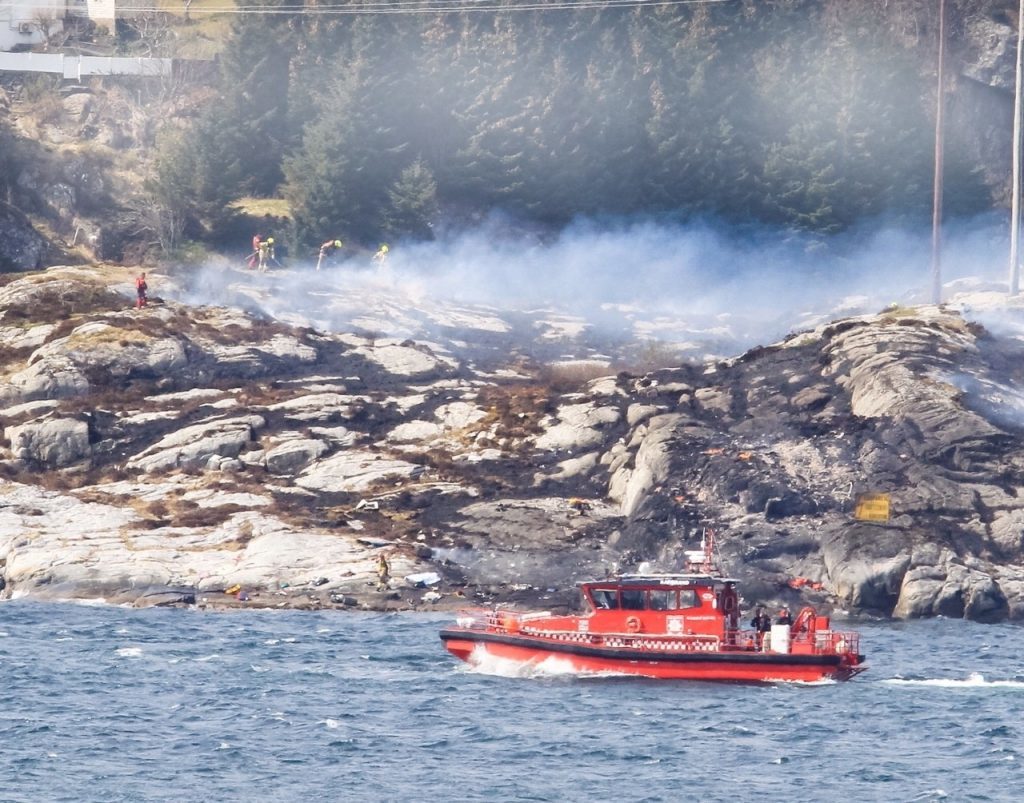
Helicopter maker Airbus said today it could not have prevented a fatal Super Puma crash in Norway two years ago despite similarities with an accident which killed 16 people near Peterhead in 2009.
Airbus said “neither aviation authorities nor industry” had ever seen the type of crack in the main gear box that led to the incident near Bergen in April 2016.
The French firm also said it had undertaken extensive analysis and introduced a set of safety measures since the crash, allowing Super Puma 225s to return to service worldwide.
But the company acknowledged there are still no Super Pumas flying to oil platforms in the UK or Norway and that “there are no immediate requirements for these aircraft in North Sea crew change operations”.
Airbus released the statement following Accident Investigation Board Norway’s (AIBN’s) publication of its final report into the crash, which killed 13 people, including Iain Stuart, 41, from Laurencekirk.
The rotor broke off due to a “fatigue fracture” in a “second stage planet gear” in the main rotor gearbox.
AIBN said it was probable that the failure was caused by tiny pieces of debris wearing away at the component. The system installed for detecting the particles was “inadequate”.
The report authors said there were “significant lessons to be learned” related to gearbox design, safety assessment and fatigue evaluation and made 12 recommendations, including the commissioning of research into “crack development”.
They said the crew was not to blame and that the failure developed in a way which was unlikely to be picked up by maintenance procedures.
No evidence was found linking the development of the crack to the involvement of the gearbox in a road accident during transport and prior to installation.
Investigators said the European aviation watchdog’s certification specifications contained “weaknesses”.
They also said very few of the gears in question reached their intended operational time before being scrapped. Airbus failed to routinely examine the parts to find reasons for this trend, according to the report.
The Super Puma crash off Peterhead in 2009 was also caused by a fatigue fracture in a second stage planet gear. However, that accident “was not fully understood at the time because the origin of the crack was in a section of the failed gear which was not recovered”.
Investigators said there was no conclusive proof that the planet gears still in service could not develop undetectable fatigue cracks.
The aircraft which crashed in Norway on April 29, 2016, was on a return journey from Equinor’s Gullfaks B platform to Bergen Airport when its main rotor suddenly detached.
Flight data showed the CHC Helicopter-operated Super Puma dropped 2,000ft in the final few seconds of its journey.
Witnesses saw an “explosion in the sky” and a spray of components coming from the engine as the rotor came off.
Super Pumas were swiftly grounded and an influx of Sikorsky S-92s was needed to fill the void.
Aviation authorities in the UK and Norway lifted the flight ban on Super Pumas in July 2017.
But they said the aircraft could not return to action until certain modifications and upgrades had been made.
The decision was criticised by trade unionists, who said Super Pumas should remain grounded until a root cause had been identified.
A survey by Airbus found that 62% of respondents would be unlikely to fly in a Super Puma ever again, given the choice.
In October 2017, several MSPs backed calls from unions for a public inquiry into North Sea helicopter safety at a cross-party debate in Holyrood.
Equinor, the new name for Statoil, has said it will never use Super Pumas again.
CHC, which was operating the copter in April 2016, no longer has any 225s in its UK fleet.
It is understood Babcock has no plans to reinstate Super Pumas, regardless of the outcome of the AIBN report.
NHV uses Airbus H175s for UK North Sea oil rig flights from Aberdeen.
Airbus said it welcomed the report’s conclusions and expressed “deep regret” for the accident.
The company said in a statement: “Neither aviation authorities nor industry had ever seen the type of crack in the main gear box that led to the accident.
“Extensive analysis of the accident has led to the development of a set of safety measures, approved by global aviation authorities, which have allowed the H225 fleet to resume flight operations worldwide.
“However, no H225s are flying in the North Sea today and we understand that there are no immediate requirements for these aircraft in North Sea crew change operations.
“There are similarities with the 2009 G-REDL accident (near Peterhead). However, without key evidence at the time, it was impossible to put in place measures which might have prevented the LN-OJF accident in Norway).”
A spokesman for CHC said: “We welcome the Accident Investigation Board Norway’s (AIBN) final report published today 5 July, 2018 into the tragic accident in Turøy, Norway on April 29, 2016.
“Our thoughts remain with the family, friends and colleagues of the 13 people lost that day including our crew Captain Olav Bastiansen and Captain Michele Vimercati and hope the publication of the final report answers many of the outstanding questions and offers some comfort.
“We have fully supported the AIBN through their two year investigation and thank them for their most thorough and professional work.”
Step Change in Safety executive director Les Linklater said: “The AIBN report, which contains far reaching recommendations, once again underlines the importance of independent investigations. The significant lessons to be learned relate to gearbox design, safety assessment, fatigue evaluation, condition monitoring, certification requirements and continued airworthiness of the AS 332 L2 and the EC 225 LP helicopters.
“Furthermore, given that most of recommendations are directed to EASA, we believe the recommendations are likely to have fleet wide implications regarding future safety improvements.
“Step Change in Safety will continue to work through the Offshore Helicopter Safety Leadership Group (OHSLG) to monitor the response from EASA and Airbus regarding these recommendations.”
